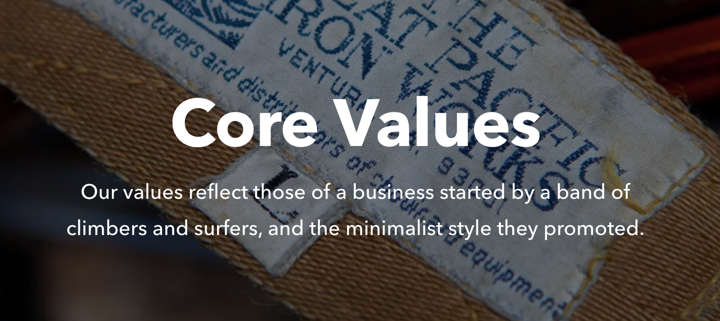by Ceillie Clark-Keane
Ceillie Clark-Keane runs content at Unstack, a no-code marketing platform.
When I think of branding, I think of Apple’s sleek website. I think of Coca-Cola’s enduring logo. I think of Monday.com’s brightly colored YouTube ads.

These are all examples of external branding, which makes sense. That’s what’s visible to consumers. But there’s also internal branding. This is how a company’s employees understand and view the brand.
Internal branding is just as important—if not more so since it’s too often overlooked. That’s why, in this guide, we’ll cover what internal branding is, plus six ways to get started at your company:
- Define your company’s mission
- Set your core values
- Feature your mission and core values on your website
- Include internal branding in employee onboarding
- Share updates with everyone
- Start an employee recognition program
Here we go.
What is internal branding?
Internal branding is the process of conveying your messaging and mission to your employees, just like you do for your external audience. This helps your employees understand why they’re doing their jobs for the company and how they’re fitting into a long-term vision.
Now, you might be thinking, this all sounds great, but does internal branding actually work? It does. A classic Harvard Business Review article explores how effective internal branding can be and points to a study done when British Petroleum rebranded to BP and launched an internal branding campaign. The results were compelling:
- 76% of employees felt good about the new brand.
- 80% were aware of the brand values that aligned with the new brand messages.
- 90% of employees felt the company was going in the right direction.
Internal branding helps employees better understand the company’s mission and develop an emotional connection to the company.
Even better, a strong internal branding strategy also helps with external branding. When your employees represent your company—whether it’s on the phone with customers, participating in industry events, or casually talking about their job with friends—it’ll be in alignment with your overall brand.
Internal branding strategy for your business
In order to improve your internal branding, your internal branding strategy has to include specific steps that you can implement over time. But that doesn’t have to be a long and drawn-out process. Here are six great ways to get started overhauling your internal branding.
1. Define your company’s mission
If your company doesn’t have a clearly defined and widely shared mission statement, then you need to start by taking the time to define that.
A mission statement simply defines why a company exists. Now, the emphasis here is on the bigger picture. Let’s take a look at Nike’s mission statement as an example:

Now, Nike’s business objective is probably to develop better sneakers and workout gear and to sell a ton of those products. The company’s mission goes a step beyond this and defines the impact that the company wants to make: bringing athletes worldwide inspiration and innovation.
If you don’t already have a mission statement, take a look at some great examples and set one now.
2. Set your core values
If your mission statement is your company’s “why,” then your core values are the “how.” Core values are the principles that drive your work and define your company culture.
For example, here are Patagonia’s core values:
- Build the best product
- Cause no unnecessary harm
- Use business to protect nature
- Not bound by convention
Patagonia even goes one step further by framing these values in an overarching statement that explains how applying these principles to the company’s work helps it stay close to its roots and the founders’ original vision.

Patagonia’s Core Values statement.
If your founders have already set some core values, that’s a great place to start. Otherwise, this is a good opportunity to get your leadership team involved, or open the process up to representatives across departments. Take the time to brainstorm what’s important now and how you can formalize that.
Just be sure to share these widely once you’re done—which leads me to my next point.
3. Feature your mission and core values on your website
There are some standard things you need to include to set up a good website for your company, like contact information, targeted keywords, and trust signals.
But to set up a good website that sets you up best for internal branding, you need to include information about your company culture, including your mission statement and your core values.
The best way to do this is to create a dedicated area on your website to add it to.
This could be its own landing page, or it could be included in your company’s “About Us” page. These pages are essential for sharing what your company does, why it does it, and who the main people on your team are.
Here’s a great example:

For more inspiration, you can check out the rest of the about pages that made Canva’s list.
4. Include internal branding in employee onboarding
When you’re starting a new job, there’s so much you want to learn right away—what your relationship with your boss looks like, when is a camera required for your Zoom, what teams you’ll be working closely with, how to use the printer.
And once you’re hired, you also want to know how everyone really sees their role fitting into the company. That’s why internal branding should be a part of the employee onboarding process.
By making sure that your newest employees are invited to learn about your company’s brand, its mission, and how their work contributes to that goal, you’re starting to personalize their employee experience right away. This could take some time, preparing a slideshow, a presentation video, or an interactive learning process, but the benefits of increasing employee engagement can be huge.
5. Share updates with everyone
Whether you have a dedicated internal communications manager or not, your business requires some internal communications. Policy changes, calls for open enrollment, and announcing your company’s holiday schedules all require an email or an update in your #general slack channel, sure.
But you should also be sharing any big changes to your branding, whether it’s a new product launch, a new tagline, or a recent award. These are great moments to keep everyone up to date on the latest company news that isn’t strictly HR policy and invite everyone to celebrate the company’s achievements.
While you’re revisiting your updates for internal branding, make sure your leadership team is on the same page about your internal communication strategy, too. This is especially important now that so many of us are working remotely for the first time.
6. Showcase your culture by showcasing your talent
The best example of your culture is the people in your organization. When your stakeholders can see authentic, real videos from the people in your organization, they will be able to understand your brand in ways that no other medium can provide. Getting started with employer brand video is easy, and there are many options on the market to bring your strategy to life. If you're looking for a good place to start, list the questions you'd want your team to answer on a testimonial video. Questions like "What is my favorite thing about my job?" or "In what ways have you grown in the last year?" are excellent starters.
7. Start an employee recognition program
This might be the last tip, but that’s because this other work is important to tackle first. Creating a meaningful employee recognition program might just have the most significant impact for your internal branding - and your employee engagement —as long as you do it right.
An employee recognition program should be formalized and it should include tangible incentives. A “thank you” from your boss is meaningful, and a “good job” from the head of your department is always going to feel great. But a formal, company-wide recognition for your commitment to the company’s mission and core values? That’s huge.
In fact, successful employee recognition programs are linked to higher employee engagement, greater job satisfaction, and lower turnover rates.

When it comes to incentives, you have options, but keep in mind that they should be appealing to everyone. Specially-designed company swag. Lunch with a co-worker on the company. Maybe even spot bonuses for hitting that quarterly goal. These rewards will not only celebrate some great employee accomplishments, but they’ll help foster shared excitement and motivation towards your company’s purpose.
Make internal branding a priority
There you have it: six internal branding tips to help strengthen your company values. Take the time to define and communicate your company’s mission and values and then put programs into place to reinforce them internally —as long as you’re doing it with your employees’ best interest in mind, it’ll be worth it in the long-term.
Compt is the #1 employee stipends platform that gives your people the freedom to choose the lifestyle perks that are best for them and their always evolving needs, even when remote. Interested in learning how Compt might benefit your company? Consult with our team or request a demo.
